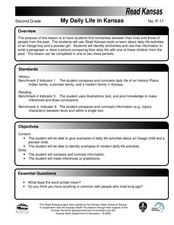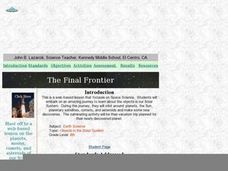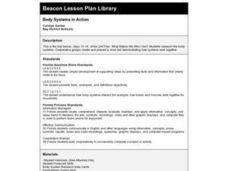Novelinks
Wildwood Dancing: Questions using Bloom’s Taxonomy of Thinking Process
Readers respond to a series of questions focused onJuliet Marillier's young adult novel Wildwood Dancing, and crafted to reflect the levels in Bloom's Taxonomy.
Curated OER
Teaching About Plate Tectonics and Faulting Using Foam Models
Young scientists learn about plate tectonics and the three different types of faults (normal, reverse, and strike-slip) using foam models. The activity also covers common types of locations where these faults are found.
Curated OER
TELL THE SEQUENCE IN AN ORAL REPORT
Second graders survey a favorite story he/she has read or heard read aloud. They use the graphic organizer to draw illustrations that show the beginning, middle and end of the story. They tell the title of the story, whether it is...
Curated OER
Reading a Science Textbook
In this skill worksheet, students get ideas about how to read a science textbook for understanding. They practice reading two paragraphs and identifying key terms and phrases.
Curated OER
My Daily Life in Kansas
Second graders use 'Read Kansas' cards to learn about the daily life activities of an Osage boy and a pioneer girl. In this similarities and differences lesson, 2nd graders write a paragraph and draw a picture comparing their daily life...
Curated OER
Planets in Our Solar System
Second graders research climate and landforms on nine planets in our solar system, choose one planet to visit, gather information about their chosen planet's climate and landforms, and "invent" space suit that would enable them to...
Curated OER
Patterns in Nature
Students examine places in nature where patterns can be observed by looking through a number of books after watching a teacher PowerPoint presentation. They illustrate a pattern in nature.
Curated OER
Where Am I: How to Read a Map
Third graders develop an understanding of maps. They explore what a map is, who uses maps, and how to use maps. Students investigate the compas rose. They create a compose rose which illustrates the cardinal directions. Students practice...
Curated OER
Read It, Don't Eat It!
Students complete activities based on the book Read It, Don't Eat It! In this library rules lesson, students are read a story that illustrates library rules, then match the rules with pictures and complete a maze.
Curated OER
Digital Fairytale
Students write a fairytale. In this writing and illustration lesson, students read and study fairytales. Students discuss the characteristics of a fairytale and then work in groups to write their own fairytale. Students divide their...
Curated OER
Read Aloud- Literary Elements- Prediction
First graders read two stories. In this literary elements instructional activity, 1st graders read The Hat by Jan Brett, notice patterns of prediction, identify the setting, problem and solution and compare the story to the book The...
Curated OER
Body Systems in Action
Fifth graders, in groups, create a short skit that shows how body systems work together.
Curated OER
Read and Draw - "ll"
In this recognizing words with the letters "ll" worksheet, learners read, write, and illustrate the words. Students complete activities for 6 words.
Curated OER
Attitudes Towards Nature in Daoist Art
Students examine Daoist art. In this art appreciation lesson, students illustrate a poem, then create a second illustration in the Daoist fashion while focusing on depicting the harmonious relationship between humans and nature.
Curated OER
The Great Kapok Tree- Teaching About Conflict in Literature
Students identify the plot of a text. In this literature instructional activity, students listen to the book The Great Kapok Tree and identify the problem and solution. A graphic organizer is used to help reinforce the concept.
Curated OER
The Science of Sleep and Daily Rhythms: Sleeping in Space
Students write about strange places that they have slept. For this sleep science lesson students read about astronauts sleeping experience in space. They reflect on unusual places that they have slept and write about it.
Curated OER
Reading a Newspaper
Students define the terms associated with parts of a newspaper. They identify various sections of a newspaper and the type of articles found in each and provide the responses to who? what? when? where? and why? contained in a ...
Curated OER
It's in the Elements - Lesson Four
Young scholars compare and contrast story elements in two versions of Cinderella. In this literature elements instructional activity, students are read two different versions of Cinderella, they identify the characters, plot, and...
Curated OER
Values: Read and Reflect
In this values instructional activity, 3rd graders will read a passage about a boy who is nervous about an oral presentation. After reading the passage, the students will choose from a list the main value demonstrated in the story and...
Curated OER
Natural Disasters: An Adventure in Non-Fiction
Learners study different natural disasters. In this natural disaster lesson students read a nonfiction book followed by a discussion, an experiment, then collect illustrations from their experience.
Curated OER
Language Arts: Creative Reading, Predicting and Writing
In this predictions worksheet, 5th graders guess what Jumanji and will be about after reading only the first line. Students write and illustrate their own short story based on the first line of Jumanji .
Curated OER
Living in a Community
Students understand the differences in communities by reading "City Mouse, Country Mouse" by Isabelle Chantellard. In this types of communities lesson, students find that although communities are different, one is not better than the...
Curated OER
Child Labor in the Carolinas
Fifth graders explore child labor and how children were exploited and used in the work place. In this Industrial Revolution lesson plan, 5th graders research child labor by reading, looking at photographs and drawing conclusions then...
Curated OER
U.S. foreign policy in the early Republic
Students research various events during the War of 1812 and then create magazine articles with supporting illustrations, students are in control of their learning.

























